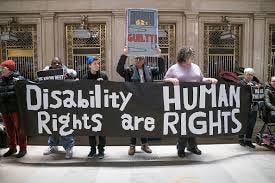Another Win for the Disability Community: A.J.T. v. Osseo Area Schools
We all deserve to learn without barriers
I want to start with some questions that may seem hypothetical, but for many disabled students, they’re a harsh reality.
What if your ability to learn in school was limited not because of your intelligence or willingness to learn, but because of your disability? What if the accommodations you needed weren’t taken seriously—or worse, were denied altogether? What if your school gave you only four hours of instruction a day while everyone else had a full schedule? How would it feel to know your education was being withheld from you, not because of your own choices, but because the system failed to support you?
What would you call that?
I call it discrimination. And unfortunately, it’s all too common in our schools today.
But there’s hope and progress. I want to tell you the story of one teenage girl and her family, who challenged an unjust system all the way to the Supreme Court of the United States in the case called A.J.T. v. Osseo Area School, and they won. Their fight has changed the legal landscape for disabled students across the country.
Meet Ava and her parents: A Brief Description of the Case
Gina and Aaron Thorpe spent years requesting that the Osseo Area School District accommodate their daughter Ava’s epilepsy by providing instructional services in the evening. Ava experiences severe seizures in the morning, which makes learning during typical school hours especially difficult. Although the district provided some accommodations, such as slightly extended instructional time, summer school sessions, and other supports, it denied the request for evening instruction. Between 2015 and 2018, Ava had been receiving only 4.25 hours of instruction per day, while students in traditional school settings received approximately 6.5 hours. Her previous school had allowed her to receive instruction in the evening, which better accommodated her disability.
The district’s Director of Student Services stated that they were unaware of the parents’ request and did not know that the district allowed home-based instruction. In 2018, Ava’s parents (A.J.T.) filed a lawsuit in federal court under Section 504 of the Rehabilitation Act of 1973 and the Americans with Disabilities Act (ADA), seeking monetary compensation.
From Lower Courts to the Nation's Highest Bench
In 2018, Ava’s family filed a lawsuit seeking monetary damages under Section 504 and the ADA. But when the case reached the Eighth Circuit Court of Appeals, it was rejected.
Why?
Because of a legal rule from a 1982 case called Monahan v. Nebraska. According to this standard, in order to successfully sue a school district for failing to accommodate a disability, students had to prove that school officials acted with “bad faith or gross misjudgment.” In other words, not only did the school have to fail, but they had to fail in a really extreme way—and the burden to prove it was placed entirely on the disabled student and their family.
This standard was unrealistic and unjust. It made it almost impossible for students like Ava to win cases when their rights were violated. But her parents refused to back down.
They took the case to the United States Supreme Court.
A Historic Victory for Disability Rights
On June 12, 2024, the Supreme Court delivered a unanimous 9-0 decision in favor of Ava and her family. In doing so, they rejected the “bad faith or gross misjudgment” standard set by the Eighth Circuit and ruled that it should not apply to cases brought under the ADA or Section 504.
This means disabled students and their families no longer have to meet an unreasonably high burden of proof in order to pursue justice when schools fail them.
In a concurring opinion, Justice Clarence Thomas—joined by Justice Brett Kavanaugh—noted that while the case raised important questions about how courts evaluate disability discrimination, it was clear that students deserve fairer standards.
This ruling is a game changer. It clears a major legal hurdle and makes it easier for disabled students across the country to hold school systems accountable for denying them equal access to education.
The Power of Community and Advocacy
Disability rights organizations across the country rallied in support of Ava and her family. They submitted amicus briefs, (aka “friend of the court), which are legal documents from individuals or groups with a strong interest in the case—and helped tell Ava’s story in court and online.
Advocates, families, and disabled individuals spoke out across social media. They understood how important this case was for Ava and every disabled student who has been denied the support they need to learn and thrive.
It was a community effort. And it worked.
Why This Case Matters to Me
As a disabled person and someone who wants to be an advocate for disability awareness rights, this case means a lot to me. I know what it feels like to fight for accommodations. I know how discouraging it is to be told “no” again and again, just because your needs don’t fit neatly into a system that wasn’t built for you. It is just so frustrating, but I also have been told “yes” many times because I had people who were in my corner all the way to my graduation from high school. They are still here today and we support each other. Even though the system isn’t built for you, you can build a new path and create new opportunities.
That’s why this Supreme Court ruling is so important because this demonstrates to Ava, her parents, and every single disabled student that their voices and education matters.
This case sends a message: disabled students matter. Their needs matter. And the law is on their side.
It gives me hope that fewer students will have to fight so hard just to be included. That future classrooms will be more flexible, more informed, and more compassionate.
The Work Isn’t Over
This case is a victory, but it’s also a reminder that we have more work to do. Discrimination against disabled students is still widespread. Schools still deny accommodations. Parents and students still have to fight too hard just to get what should be guaranteed.
But A.J.T. v. Osseo Area Schools moves us one step closer to equity. It strengthens the legal tools available to students and families. It shows that the courts are listening. And it reminds schools that they are responsible for meeting the needs of all students.
A Message to Future Changemakers
To anyone who wants to be an educator, a teacher, an advocate, or a lawyer:
Do your research.
Learn about disability rights.
Find real strategies to support your students or clients.
Listen to disabled voices.
You have the power to open doors. Use it.
Discussion question: If you were an educator, advocate, or policymaker, how would you help ensure that disabled students get the services and accommodations they need to thrive in school?
Love Enable Everything
Sources
https://www.usatoday.com/story/news/politics/2025/06/12/supreme-court-decision-student-disability-discrimination-case/83776317007/
https://www.supremecourt.gov/opinions/24pdf/24-249_a86c.pdf
https://www.k12dive.com/news/AJT-v-Osseo-Area-Schools-oral-arguments-blatt-martinez/746557/
*This is the opinion of Enable Everything. Please fact-check everything.*






THANK YOU, Jasmine for writing about this. I had been eagerly awaiting the Supreme Court decision and am ecstatic that they ruled in the Thorpe's favor -- unanimously, no less! Nice to see a bit of good news on the disability front.